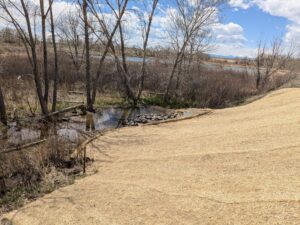Why Stormwater Compliance Matters for Construction Projects

Erosion Control Blanket installed on a slope.
In last week’s blog, “What is Stormwater Compliance?”, we explained the basics of what stormwater compliance is and the necessary agencies involved. For contractors, developers, and project managers, understanding why stormwater compliance is critical on a construction site and how to implement it is just as important as knowing what it is. This blog will expand on why stormwater compliance is so important, specifically for construction sites, and the process of staying compliant.
Stormwater and Construction Sites
When rain or snow falls and creates flows across surfaces including exposed soil and disturbed ground, it can carry sediment, chemicals, trash, and other pollutants into storm drains and nearby waterways. Construction sites are particularly vulnerable because activities like grading, excavation, and stockpiling disturb large areas of land, leaving soils exposed. In addition, construction sites typically utilize concrete washouts, fuels, chemicals, and produce large amounts of trash, which are also susceptible to stormwater. Without proper controls, construction stormwater runoff can become one of the largest sources of pollution (specifically sediment pollution) in rivers and streams.
To reduce these impacts, federal and state stormwater compliance programs require construction sites to implement best management practices (BMPs). BMPs are physical, structural, or procedural controls that minimize the potential for pollutants to leave a site.
As we mentioned in last week’s blog, there are several moving parts to keeping a construction site compliant with stormwater regulations. A successful stormwater compliance implementation generally involves five key steps:
- Planning – A qualified professional develops a Stormwater Management Plan (SWMP/SWPPP) which includes an Erosion and Sediment Control Map (GEC/GESC/EC). The SWMP is a detailed written document that explains how a construction site will control erosion, manage runoff, and prevent stormwater pollution throughout the project. The EC plan map is often prepared as part of the civil drawing set and identifies where and which BMPs—such as silt fences, inlet protection, or vehicle tracking controls—are best suited for the project based on its size, topography, soil types, and planned construction activities.
- Obtaining Permits – Depending on the location and size of the project, different permits may be required. In Colorado, the CDPS will require a stormwater discharge permit when a project disturbs over 1 acre of land or is part of a larger development project. The permit states that BMPs must be installed correctly, maintained, and require routine inspections to ensure their effectiveness. Depending on the project’s jurisdiction a city/county/local permit may also be required.
- Installation and Maintenance – It is not enough to just install BMPs; they must be properly installed and actively maintained. For example, a silt fence that is not staked correctly will not function effectively, and poorly stabilized slopes can quickly erode during a storm. Ongoing observation and maintenance is critical to preventing off-site discharges.
- Inspection and Documentation – In Colorado, routine inspections are required by the Colorado Discharge Permit System (CDPS). Active construction sites disturbing one acre or more must typically be inspected at least once every 14 days and after each precipitation that causes surface erosion. These inspections ensure that BMPs are functioning, deficiencies are corrected quickly, and compliance records are properly maintained.
- Training Crews on Stormwater Pollution Prevention Practices – Awareness within project crews helps make the stormwater compliance system easier to maintain. When everyone does their part and keeps an eye out for noncompliance issues, damaged BMPs, or potential runoff concerns, regulatory requirements are easier to meet and water quality protections remain effective.
Why Staying Compliant Matters
Failing to maintain construction site stormwater controls comes with significant consequences:
- Regulatory penalties: Noncompliance with a construction stormwater permit can result in steep fines and even stop-work orders.
- Project delays: Stormwater violations often lead to unexpected inspections, mandated corrections, and costly schedule disruptions.
- Environmental impacts: Sediment is one of the leading causes of water quality impairment nationwide, harming aquatic life and degrading community resources.
- Reputation risks: Communities and clients are increasingly attentive to environmental responsibility—violations can damage trust and credibility.
On the flip side, compliance demonstrates professionalism, safeguards project timelines, and helps protect natural resources.
Partnering for Compliance Success
Managing stormwater regulations alongside an active construction schedule can be overwhelming. Stormwater compliance may feel like one more box to check, but in reality, it’s essential to project success, community trust, and environmental stewardship. That’s where an experienced stormwater partner makes the difference.
At Summit Services Group, we help clients navigate every stage of stormwater compliance for construction—from permit applications and SWMP development to routine inspections and preparation for state visits. Our goal is to streamline compliance and reduce the burden on your team, so you can focus on running your project.
Learn how Summit manages full project compliance and keep your construction projects running smoothly, on time, and in compliance.
